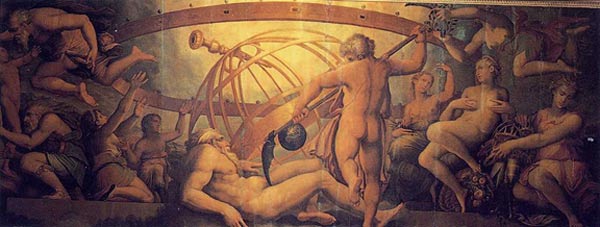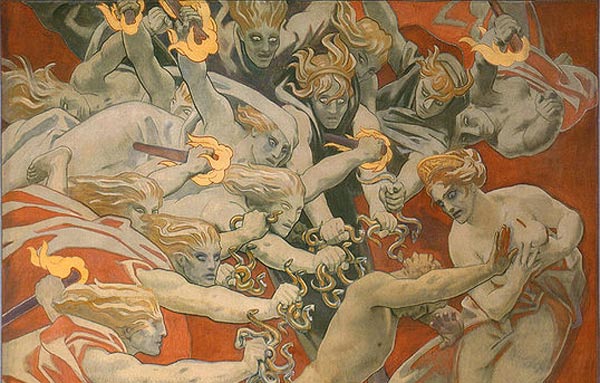The Legendary Erinyes or Furies of Ancient Greek Mythology
The Furies of Greek mythology are monstrous women who lived in the underworld and avenged murders, particularly matricides. In Greek they are called Erinyes, a name thought to have come from the Arcadian word meaning, “to be angry,” hence the English name “Furies.”
The creatures first appear in Homer’s Iliad as punishers of oath-breakers and as embodied curses of parents wronged by their children. Their function would eventually narrow to be primarily avengers of the angry dead, but in Homer they are more generally enforcers of the proper order of things. In this role, they are even said to be responsible for stopping the warrior Achilles’ horse from talking, since a talking horse is outside of the natural order of things.
Hesiod was a Greek poet of an age with Homer, and his Theogony was heavily influential in the way Greeks thought of their gods. In this story, Gaia, the goddess of the earth, convinces her son Cronus to castrate his father Uranos, the god of the sky. Cronus castrates and deposes his father, then takes his place as ruler of heaven. From the blood of Uranos’ severed genitals landing on the earth, the Erinyes are born.

Giorgio Vasari: The Mutilation of Uranus by Saturn (Cronus). (Wikipedia)
Despite these vivid presentations of Erinyes, the creatures did not have a well-defined appearance until the Greek tragedian Aeschylus featured them in his trilogy, the Oresteia. In this three-part tale, King Agamemnon returns home victorious after the Trojan War, only to be killed by his wife Clytemnestra as revenge for him sacrificing their daughter to the gods. Their son, Orestes, learns what his mother has done and murders her. In the final play of the trilogy, the Erinyes, goaded by Clytemnestra’s vehement ghost, rise up from the underworld and hunt Orestes down.

The Ghost of Clytemnestra Awakening the Furies by John Downman (1750-1824). (Wikipedia)
The Erinyes resemble Gorgons with their snaky hair. They are said to have been so frightening when they appeared on stage women in the audience miscarried. In the play, they stalk Orestes to Athens, threatening to murder him and drink his blood. “We drive matricides from their homes,” they say. ”We are called Curses in our home below the earth.”

William-Adolphe Bouguereau – “The Remorse of Orestes” (1862). (Wikipedia)
The loathsome Erinyes are finally placated by the goddess Athena, who holds a formal trial for Orestes and casts the deciding vote for his freedom. Athena convinces the Erinyes to take up a place of honor at Athens and become the goddesses of the court, locally worshipped as the Venerated Ones.
The final play in the trilogy was called Eumenides, meaning “Kindly Ones.” This name became interchangeable with Erinyes for Greek writers. It is thought to be a euphemism so that people could avoid saying their real name. After this play was performed in the fifth century BC, the Erinyes their reputation was cemented as avengers of those murdered by their own family members.

The Fury near the top of the vase is adorned with her characteristic snakes. (Wikimedia)
In Aeschylus’ tale, the Erinyes were daughters of Night, not Uranos. The Greek writer Apollodorus would revert back to the original genealogy in his Library, where he numbers the creatures at three and identifies them as Alecto, Tisiphone, and Megaera.
The great Roman poets Vergil and Ovid would include the Furies, Latin furiales, in their depictions of the underworld. In Ovid’s Metemorphoses, a spellbinding catalogue of hundreds of Greek and Roman myths, the goddess Juno visits the underworld and finds Tisiphone and her sisters combing snakes from their hair. Juno’s orders the Furies to punish Ino, a mortal who had offended Juno. Tisiphone and her frightening cohort, including creatures called Grief, Fear, Terror, and Madness, visit the house of Ino and her husband Athamas.
From the middle of her hair she seized two snakes
And threw them with a pestilential hand.
The snakes terrified the hearts of Ino and Athamas
And breathed sickness into their minds.
(Ovid, Metamorphoses 4.495-8)
The mortals become infected with madness. Athamas murders one of his children. Ino flees with the other until she is forced to jump off a cliff into the sea.
The Furies in Ovid’s story are not the enforcers of the natural order we met in Homer. By the first century AD their reputation had changed to be fearsome creatures who love to wreak havoc.
In each of these stories, the Furies are especially associated with snakes. This is because in ancient Greek religion, snakes were closely linked with the dead. Snakes would often appear at gravesites to lap up libations and sacrifices offered to the dead. There was even a belief that when a dead body breaks down, the spine slithers off as a snake. The Erinyes, adorned with snakes, have instilled terror for centuries by embodying the dead.
Featured image: Orestes Pursued by the Furies (1921) by John Singer Sargent. (Wikimedia)
Sources:
Homer, Iliad
Hesiod, Theogony
Aeschylus, Oresteia
Apollodorus, Library
Vergil, Aeneid
Ovid, Metamorphoses
Aelian, On Animals
Further reading:
Walter Burkert, Greek Religion (1985)
Jane E. Harrison, Prolegomena to the study of Greek Religion (1991)


















Comments
great info. tanks!
keep posting
Should Look into ezechiel and what farao Imhotep promissed to do to Mankind 8000 years ago as revenge against Noah and made Mankind a self anihilating pile of rubish. You even Can Recognise todays World out of it!
The banks are a part of that fatwa of anihilation. It means bá Anc kill God.. and their religions have a baal soul bá All anihilate Creation. A fatwa of an old farao. And reason Noah and the last surviving 25.004 Israelites had to Flee off Earth